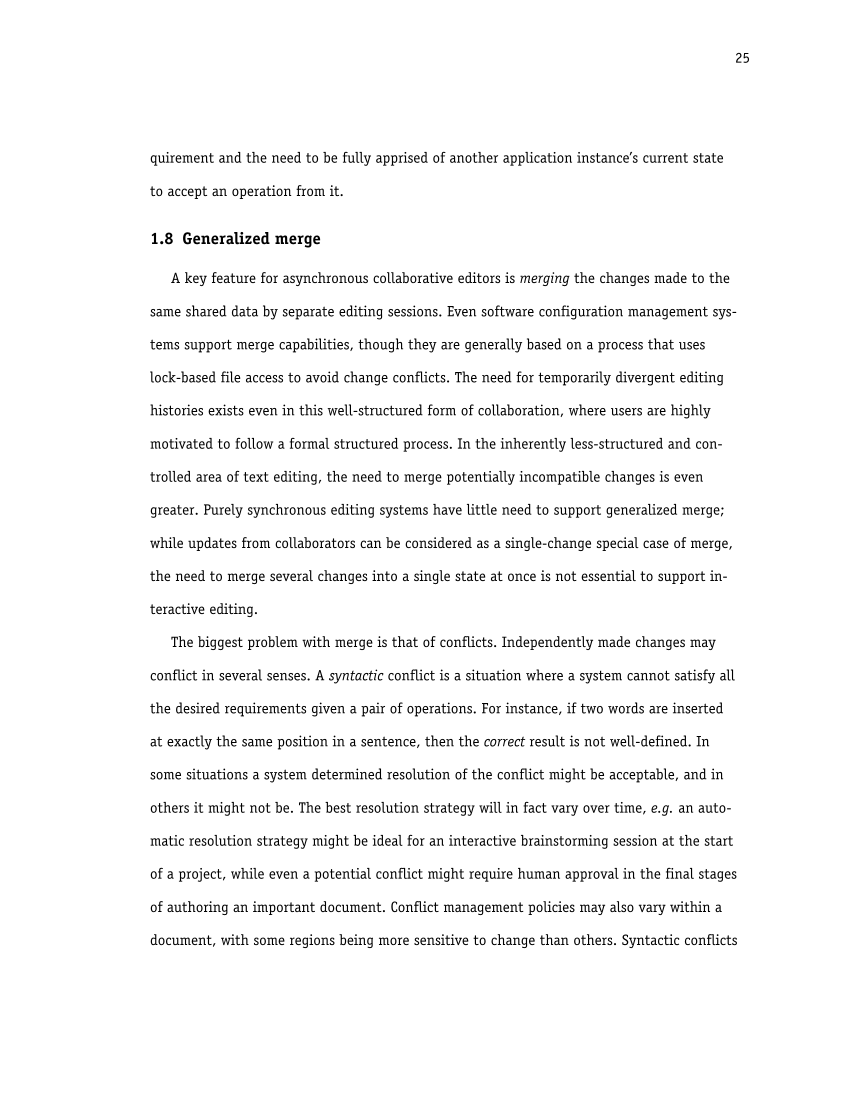25
quirement�and�the�need�to�be�fully�apprised�of�another�application�instance’s�current�state
to�accept�an�operation�from�it.
1.8 Generalized�merge
A�key�feature�for�asynchronous�collaborative�editors�is�mergingthe�changes�made�to�the
same�shared�data�by�separate�editing�sessions.�Even�software�configuration�management�sys-
tems�support�merge�capabilities,�though�they�are�generally�based�on�a�process�that�uses
lock-based�file�access�to�avoid�change�conflicts.�The�need�for�temporarily�divergent�editing
histories�exists�even�in�this�well-structured�form�of�collaboration,�where�users�are�highly
motivated�to�follow�a�formal�structured�process.�In�the�inherently�less-structured�and�con-
trolled�area�of�text�editing,�the�need�to�merge�potentially�incompatible�changes�is�even
greater.�Purely�synchronous�editing�systems�have�little�need�to�support�generalized�merge;
while�updates�from�collaborators�can�be�considered�as�a�single-change�special�case�of�merge,
the�need�to�merge�several�changes�into�a�single�state�at�once�is�not�essential�to�support�in-
teractive�editing.
The�biggest�problem�with�merge�is�that�of�conflicts.�Independently�made�changes�may
conflict�in�several�senses.�A�syntacticconflict�is�a�situation�where�a�system�cannot�satisfy�all
the�desired�requirements�given�a�pair�of�operations.�For�instance,�if�two�words�are�inserted
at�exactly�the�same�position�in�a�sentence,�then�the�correctresult�is�not�well-defined.�In
some�situations�a�system�determined�resolution�of�the�conflict�might�be�acceptable,�and�in
others�it�might�not�be.�The�best�resolution�strategy�will�in�fact�vary�over�time,�e.g.an�auto-
matic�resolution�strategy�might�be�ideal�for�an�interactive�brainstorming�session�at�the�start
of�a�project,�while�even�a�potential�conflict�might�require�human�approval�in�the�final�stages
of�authoring�an�important�document.�Conflict�management�policies�may�also�vary�within�a
document,�with�some�regions�being�more�sensitive�to�change�than�others.�Syntactic�conflicts
quirement�and�the�need�to�be�fully�apprised�of�another�application�instance’s�current�state
to�accept�an�operation�from�it.
1.8 Generalized�merge
A�key�feature�for�asynchronous�collaborative�editors�is�mergingthe�changes�made�to�the
same�shared�data�by�separate�editing�sessions.�Even�software�configuration�management�sys-
tems�support�merge�capabilities,�though�they�are�generally�based�on�a�process�that�uses
lock-based�file�access�to�avoid�change�conflicts.�The�need�for�temporarily�divergent�editing
histories�exists�even�in�this�well-structured�form�of�collaboration,�where�users�are�highly
motivated�to�follow�a�formal�structured�process.�In�the�inherently�less-structured�and�con-
trolled�area�of�text�editing,�the�need�to�merge�potentially�incompatible�changes�is�even
greater.�Purely�synchronous�editing�systems�have�little�need�to�support�generalized�merge;
while�updates�from�collaborators�can�be�considered�as�a�single-change�special�case�of�merge,
the�need�to�merge�several�changes�into�a�single�state�at�once�is�not�essential�to�support�in-
teractive�editing.
The�biggest�problem�with�merge�is�that�of�conflicts.�Independently�made�changes�may
conflict�in�several�senses.�A�syntacticconflict�is�a�situation�where�a�system�cannot�satisfy�all
the�desired�requirements�given�a�pair�of�operations.�For�instance,�if�two�words�are�inserted
at�exactly�the�same�position�in�a�sentence,�then�the�correctresult�is�not�well-defined.�In
some�situations�a�system�determined�resolution�of�the�conflict�might�be�acceptable,�and�in
others�it�might�not�be.�The�best�resolution�strategy�will�in�fact�vary�over�time,�e.g.an�auto-
matic�resolution�strategy�might�be�ideal�for�an�interactive�brainstorming�session�at�the�start
of�a�project,�while�even�a�potential�conflict�might�require�human�approval�in�the�final�stages
of�authoring�an�important�document.�Conflict�management�policies�may�also�vary�within�a
document,�with�some�regions�being�more�sensitive�to�change�than�others.�Syntactic�conflicts





























































































































































































